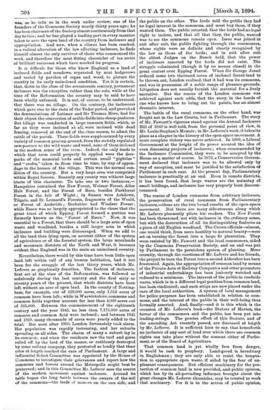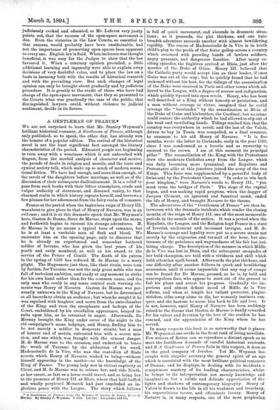ENGLISH COMMONS AND FORESTS.* IT is not often, that it
is given to a man, first to make history, and then to write it. This, in effect, is what Mr. Shaw Lefevre has done in relation to the preservation of commons. He • English Commons and Forests: the Story of the Battle during the Last Thirty Years for Piddle Bights over the Commons and Forests of England and Wales. By the Right lion. G. Shaw-Leforre, M.P. London : Cassell and Co.
was, as he tells us in the work under review, one of the founders of the Commons Society nearly thirty years ago; he has been chairman of the Society almost continuously from that day to this; and he has played a leading part in every measure taken to save the open land of the country from inclosure and appropriation. And now, when a climax has been reached, in a radical alteration of the law affecting inclosure, he finds himself almost the only survivor of those who commenced the work, and therefore the most fitting chronicler of tne series of brilliant successes which have marked its progress.
It is difficult for those who know England as a land of inclosed fields and meadows, separated by neat hedgerows and varied by patches of copse and wood, to picture the country in its early uninclosed condition. Yet it is certain, that, down to the close of the seventeenth century, permanent inclosure was the exception rather than the rule, while at the time of the Reformation the country may be said to have been wholly unfenced. It is not, of course, to be understood, that there was no tillage. On the contrary, the inclosures which gave rise to the riots of the Tador period, and provoked the denunciations of Latimer and Sir Thomas More, had for their object the conversion of arable fields into sheep-pastures. But tillage was conducted in large common fields, which, so far as they were inclosed at all, were inclosed with dead fencing, removed at the end of the close season, to admit the cattle of the parish. These fields were supplemented by every variety of common grazing-ground, from the strictly regulated cow-pasture to the wild waste and wood, none of them inclosed in the modern sense of the term. Indeed, the only lands to which that term could properly be applied were the deer- parks of the manorial lords and certain small "pightles " and "crofts," taken in from time to time, by way of appen- dage to the houses of the village. This was the normal con- dition of the country. But a very large area was comprised within Royal forests. Scarcely any county was without large tracts of this character. To take one or two instances,— Hampshire contained the New Forest, Wolmer Forest, Alice Holt Forest, and the Forest of Bere, besides Parkhurst Forest in the Isle of Wight ; in Sussex were Ashdown, Tilgate, and St. Leonard's Forests, fragments of the Weald, or Forest of Anderida ; Berkshire had Windsor Forest ; while Essex was so largely appropriated to the chase that the great tract of which Epping Forest formed a portion was formerly known as the " Forest of Essex." Now, it was essential to a Forest, that there should be a large area of open waste and woodland, besides a still larger area in which inclosnre and building were discouraged. When we add to all the land thus lying open, on account either of the system of agriculture or of the forestal system, the large moorlands and mountain districts of the North and West, it becomes evident, that England was in the main an uninclosed country.
Nevertheless, there would by this time have been little open land left within call of any human habitation, had it not been for the struggle of the last thirty years, which Mr. Lefevre so graphically describes. The fashion of inclosure, first set at the time of the Reformation, was followed so sedulously during the last century and the first sixty or seventy years of the present, that whole districts have been left without an acre of open land. In the county of Notting- ham, for example, out of 529,000 acres, only 1,513 acres of common have been left ; while in Warwickshire, commons and common fields together account for less than 4,000 acres out of 565,000. Between the commencement of the eighteenth century and the year 1845, no less than 7,175,000 acres of common and common field were inclosed ; and between 1845 and 1869. many thousands of acres were yearly added to the total. But soon after 1860, London fortunately took alarm. Her population was rapidly increasing, and her suburbs spreading on all sides. The charm of many a suburb lay in its common; and when the residents saw the turf and gorse railed off by the lord of the manor, or ruthlessly destroyed by some railway company, they protested so loudly that their cries at length reached the ears of Parliament. A large and influential Select Committee was appointed by the House of Commons to investigate their grievances and report how the commons and forests around the Metropolis might best be preserved ; and in this Committee Mr. Lefevre sees the source of the modern movement against inclosure. Around its table began the long battle between the owners of the soil of the commons—the lords of manors on the one side, and
the public on the other. The lords told the public they had no legal interest in the commons, and must buy them, if they wanted them. The public retorted, that the lords had no legal right to inclose, and that all that they, the public, wanted was to see the commons remain open. Issue was joined in suit after suit, the public fighting through the commoners, whose rights were as definite and clearly recognised by the law as those of the lords ; and in suit after suit the ablest Judges on the Bench held, that the power of inclosure asserted by the lords did not exist. The struggle culminated (though it by no means closed) in the- great contest over Epping Forest. When Sir George Jessel ordered some two thousand acres of inclosed forest-land to be thrown out, London realised, that it had won its commons,. and was in possession of a noble range of pleasure-grounds. Litigation does not usually furnish the material for a lively narrative. But the rescue of the London commons was achieved against such odds, that the story, in the hands of one who knows how to bring out the points, has an almost, dramatic interest.
The battle of the rural commons, on the other hand, was fought not in the Law Courts, but in Parliament. The story of Mr. Fawcett's vigorous stand against the Annual Inclosure Bill of 1869 is well told, from the personal point of view, in Mr. Leslie Stephen's Memoir; in Mr. Lefevre's work, it takes its place as a chapter in the history of the open-space movement. A more complete victory was never achieved. In 1869, a Liberal Government at the height of its power scouted the idea of even discussing projects of inclosure ; when recommended by the Inclosure Commission, they were to be accepted by the House as a matter of course. In 1876, a Conservative Govern- ment declared that inclosure was to be allowed only by way of exception, and must be justified to the satisfaction of Parliament in each case. At the present day, Parliamentary inclosure is practically at an end. Even in remote districts, it has been found, that large wastes are the mainstay of small holdings, and inclosure has very properly been discoun- tenanced.
The rescue of London commons from arbitrary inclosure, the preservation of rural commons from Parliamentary inclosure,—these are the two broad results of the open-space movement. But there are many side-streams along which Mr. Lefevre pleasantly pilots his readers. The New Forest has been threatened, not with inclosure in the ordinary sense, but with the destruction of all its distinguishing features as a piece of old English woodland. The Crown officials—almost, one would think, from mere hostility to natural beauty—were set on turning the forest into a large fir plantation. They were resisted by Mr. Fawcett and the local commoners, aided by the Commons Preservation Society, and an end was put by Parliament to the pernicious system of planting. More recently, through the exertions of Mr. Lefevre and his friends, the project to turn the Forest into a second Aldershot has been frustrated. Again, the appropriation of common land by means of the Private Acts of Railway Companies and other promoters of industrial undertakings has been jealously watched and reduced to a minimum. The interest of the public in roadside waste, which is in a different legal position from common land, has been vindicated; and such strips are now placed under the care of the local authorities. A system of local management for police purposes has been established in relation to com- mons, and the interest of the public in their well-being thus formallyasserted. And, finally—and it is this which is the occasion of Mr. Lefevre's book—the Statute of Merton, the terror of the commoners and the public, has been put into- leading-strings. The precise effect of this Statute, and of the amending Act recently passed, are discussed at length by Mr. Lefevre. It is sufficient here to say. that henceforth no inolosure of any sort of land over which there are common rights can take place without the consent either of Parlia- ment or of the Board of Agriculture.
That common land is yet wholly free from danger, it would be rash to prophecy. Land-greed is hereditary in Englishmen ; they are only able to resist the tempta- tion to appropriate open waste, if aided by the fear of un- pleasant consequences. But efficient machinery for the pro- tection of common land is now provided, and public opinion, which has by its all-pervading influence brought about the great changes Mr. Lefevre chronicles, may be trusted to work that machinery. For it is to the action of public opinion, judiciously evoked and educated, as Mr. Lefevre very justly points out, that the success of the open-space movement is due. Even the victories in the Law Courts, so essential to that success, would probably have been unattainable, had not the importance of preserving open spaces been apparent to every one. English law is fluid. When inclosure was thought beneficial, it was easy for the Judges to show that the law favoured it. When a contrary opinion prevailed, a little additional learning and ingenuity were able to explain away decisions of very doubtful value, and to place the law on a basis in harmony both with the results of historical research and with the prevailing view. But such changes of legal opinion can only be brought about gradually and by judicious procedure. It is greatly to the credit of those who have had charge of the open-space movement, that they so presented to the Courts what was practically the case of the public, that distinguished lawyers could, without violence to judicial sentiment, decide in its favour.








































 Previous page
Previous page